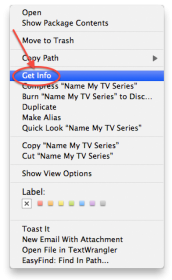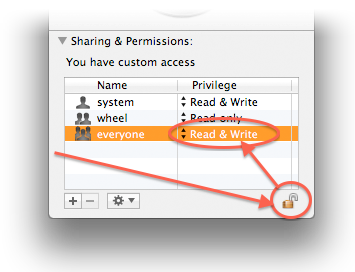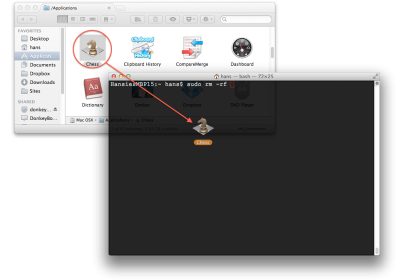MacOS X Lion (and other MacOS versions up to MacOS X El Capitan) come with few preinstalled applications like “Chess”, but you cannot remove/uninstall them the conventional way …
A waste of diskspace when you don’t really need the application (especially when you’re running low on space on your snappy SSD drive) …
A short article on how to remove these guys …
Can’t remove that Application?
When you try to uninstall some of the pre-installed applications – “Chess” or “GarageBand” for example – by dragging it to the trash will make your Mac prevent you from doing so and a message makes clear that the application cannot be modified or deleted because it’s required by Mac OS X …
In this example (Chess) nonsense of course …
Apple most likely locked these files to prevent newbies from deleting them by accident.
So how can we remove such a space waster …?
This will not work on Catalina …
For those using macOS Catalina: This trick may no longer work.
Apple has locked down the filesystem even more, and removing pre-installed applications has become quite difficult and I can no longer recommend even doing it.
System Integrity Protection with El Capitan (10.1) and higher …
One of the visitors of Tweaking4All (Abbey) discovered that these tricks no longer work under El Capitan, and probably will not work under newer MacOS X (or: macOS) versions due to the new “System Integrity Protection” which prevents users from deleting certain files, even when you’re system administrator or use sudo.
A work around would be by temporary disabling System Integrity Protection, but I advise against doing that.
If you really know what you’re doing, try these steps to disable SIP:
- Restart your Mac.
- Before OS X starts up, hold down Command-R and keep it held down until you see an Apple icon and a progress bar.
Release both keys. This boots you into Recovery.
- From the Utilities menu, select Terminal.
- At the prompt type exactly the following and then press Return:
csrutil disable
- Terminal should display a message that SIP was disabled.
- From the menu, select Restart.
After removing the unwanted applications, you can re-enable SIP by following the above steps, and using csrutil enable instead.
Ad Blocking Detected Please consider disabling your ad blocker for our website.
We rely on these ads to be able to run our website.
You can of course support us in other ways (see Support Us on the left).
Option 1 – Change the access rights and drag it to the trash
The easiest option, I think, is to change the access rights in the Finder.
The biggest advantage over the 2nd option is that the file ends up in the Trash and you can actually put it back if needed.
- Right click (or CTRL + left click) the application you’d like to delete (“Chess” in this example).
- From the menu select the option “Get Info“.

MacOS X – Right Click the file and select the “Get Info” option
- A window with additional file info will open, and at the bottom you will find a section called “Sharing & Permissions” – here you will see that the “rights” for “everyone” is set to “Read Only“, which we want to change to “Read & Write“.- Click the pad-lock in the lower right corner to unlock it – your password will be asked, enter it.- Set the rights next to “everyone” to “Read & Write“.Optionally click the pad-lock again to lock it.

MacOS X – Sharing & Permissions settings
- You can now close this window and finally drag the application to the Trash.
Option 2 – Terminal to the Rescue …?
A seemingly much easier and more permanent way to do this is by using the Terminal.
CAUTION
The selected application will be deleted PERMANENTLY – so you will NOT find it in the trash!
- Open a Terminal window (goto “Applications” → “Utilities” and double click “Terminal“).
- Type the following (there is a space after “rf”! DO NOT press ENTER).
- Next drag the icon of the application from your “Applications” folder onto the Terminal window.

MacOS X – Drag and drop the icon onto the Terminal Window
- You will now see the text change in your Terminal window to:
sudo rm -rf /Applications/Chess.app
- Press the ENTER key, your password will be asked, enter it and press the ENTER key again and you application is deleted …
WARNING – BE CAREFUL!
The use of SUDO and the RM command can be a very dangerous combination.SUDO for one brings the execution of the following command to Administrator level (ie. “root” level) – not much will stop you from doing crazy stuff.
RM -RF is the shell command for a recursive (R) forced (F) removing of a file or folder.
Recursive means: wax everything in that folder as well (folders and files)!
Ad Blocking Detected Please consider disabling your ad blocker for our website.
We rely on these ads to be able to run our website.
You can of course support us in other ways (see Support Us on the left).
This is all there is to it?
Well, with some applications it is, with some it’s not.
Some applications store settings and additional files for example elsewhere on your harddrive; “GarageBand” which stores plenty of audio files in a “hidden” location (app. 100 Mb on my computer anyway). The “hidden” location of those files, for “GarageBand”, can be found here:
/Library/Audio/Apple Loops/Apple/Apple Loops for GarageBand
Feel free to delete those.




Comments
There are 22 comments. You can read them below.
You can post your own comments by using the form below, or reply to existing comments by using the "Reply" button.
thank you ! i had an addiction with this chess game, and now i got rid of it
anne
Hi Anne!
Thanks for leaving a comment! Glad it worked for you as well!
hans
Hi, I’m having trouble with both these options in el capitan. The terminal option comes up with 30+ text inserts saying that this operation is not permitted. Same as trying to change the access rights. I am the admin of the computer I am trying to do this with if it helps!
Abbey
Hi Abbey,
thank you for reporting this issue with El Capitan.
I just tested this on my Mac (also El Capitan) and can confirm that this does no longer work as of El Capitan.
The new “System Integrity Protection” seems to prevent us from deleting useless applications.
System Integrity Protection however can be disabled, but I would not recommend going that route.
Follow these steps to disable SIP, only do this if you’re 100% sure what you’re doing!
– Restart your Mac.
– Before OS X starts up, hold down Command-R and keep it held down until you see an Apple icon and a progress bar.
Release both kets. This boots you into Recovery.
– From the Utilities menu, select Terminal.
– At the prompt type exactly the following and then press Return: csrutil disable
– Terminal should display a message that SIP was disabled.
– From the menu, select Restart.
Remove the applications you want to remove and when done, re-enable System Integrity Protection by repeating the previous steps, however instead of “csrutil disable”, use csrutil enable instead.
hans
You can also use a nice free utility app named: AppCleaner, it has the option to remove protected apps. Also, there is another nice utility called PermissionsReset, where you can simply drag the whole Applications directory into it and set the permissions to your username.
Bryan
Thanks for the tip Bryan!
The link for those apps: AppCleaner and PermissionReset.
Note that I have not tested either app …
hans
AppCleaner: https://www.macupdate.com/app/mac/25276/appcleaner
PermissionReset: https://www.macupdate.com/app/mac/31741/permissions-reset
Bryan
Thanks Bryan!
hans
I’ve always like AppZapper. you have to go into the preference and uncheck Keep Apple applications safe
John Smith
Thanks John for the great tip!
I’m testing “Delete Apps: Uninstaller” (from the App store, free and no in-app purchases needed), which may be a good choice as well.
hans
I already tried to changed the permissions starting from the csrutil disable, but it’s still appearing the message “It’s not possible to complete the the operation because you have not necessary permissions”.
Then I tried to uninstall the chess app with app cleaner and it was the same story.
In conclusion, I don’t know how to change the chess permissions on Mojave 10.15.
Any idea how can I dealt chess app?
Eduardo
Hi Eduardo!
With Catalina, permissions (read: Security) has changed drastically, especially considering when this article was written (2013).
I’m afraid Apple has nailed a lot of things shut with that and removing (even with csrutil) is either very hard or not even possible …
I did find this post though, but I have to say that I have not tried this myself – so use it at your own risk:
(let us know what you findings are )
)
hans
Hi!
I used this method to delete the Stickies App in Catalina. It works! (But I didn’t use step #3.)
I am very grateful to people online who take the time to share their knowledge of macOS etc.
Thank you!
Raj
Hi Raj,
glad to hear folks still have a use for this!
Thank you for taking the time to post a thank-you – it is very much appreciated
Hans
Eduardo,
I am experiencing the exact same problem that you are having with Catalina. Not even sudo works
guest
Hi Guest,
It’s Catalina that limits the users access to the filesystem even more than Mojave already did.
Unfortunately this is one of Apple’s ways to increase security.
Hopefully Apple will realize that users want garbage of their Macs, and will allow removal of unused applications like they are allowing this in iOS as well.
I cannot imagine (for example) what would be critical about the Chess application. For me it just wastes disk space.
Maybe if enough users complain on the macOS Feedback page, things could change …
hans
I tired to do this to uninstall a terminal downloaded to my Mac. when I did the sudo rm it said illegal option after I entered my password. When I tried to use the first method it said I didn’t have the right authorization/permission even after I unlocked it to change it to “read and write”. Im not sure what to do but it feels like someone is hacked into my laptop. Why is it so hard for me to delete it?
Narnia
Hi Narnia,
I’m not sure what you’re trying to delete.
Was this a pre-installed application from Apple?
You mention “a terminal” but I’m not sure what you mean with that.
Please elaborate.
As for pre-installed applications that come with macOS;
Apple has been on a mission to nail the filesystem as shut as they possibly can.
In the process breaking a few things left and right, and of course: you not being able to remove an application.
p.s. this does not necessarily mean that anyone hacked your computer.
hans
Says illegal operation when I Use:sudo rm -rf
T kimbal
Hi T Kimbal,
I t doesn’t surprise me that this no longer works for more recent macOS versions (remember; this article was written in 2013).
The current macOS versions use SIP (System Integrity Protection) which will block things like this.
If you still want to remove certain default apps (be careful!), you’ll have to disable SIP first, then remove the app, and then enable SIP again.
–> Again: be careful, since you may damage things !!!
1. Restart your computer in Recovery mode (during boot hold Command (⌘) and R).
2. Launch Terminal from the Utilities menu.
3. Run the command
4. Restart your computer.
2. Launch Terminal from the Utilities menu.
3. Run the command
Hans
Hi All,
Thanks for the process for removing unwanted pre-installed apps on macbook. It’s just the ‘get info’ method which I think is the most sensible for me with my limited techy knowledge. Each time I tried to change from ‘read only’ to ‘read and write’ I get the message that I do not have access even though I’ve signed in after clicking the key to unlock. Please advise on what to do.
Kind regards,
Enoch
Enoch
Hi Enoch,
unfortunately, the described method is quite outdated (2013 – so about 8 years old).
The only way this may work is by disabling (temporary) the SIP protection. I cannot really recommend this, especially if you’re not an expert.
I did describe this method in the comment above – but again: I cannot recommend this if you’re not an experienced user.
Also note: some of the default macOS applications can be removed nonetheless.
You can try this by dragging them to the trash, or select the application and press ⌘+Delete.
Hans